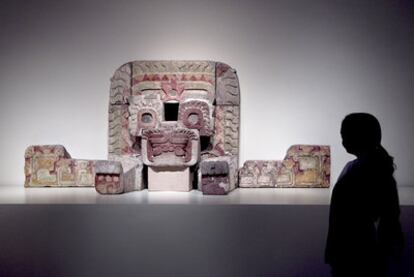Where gods were created
CaixaForum exhibition reveals the mysteries of Teotihuacán
On March 20, coinciding with the spring equinox, around 160,000 people laboriously climbed 63 meters to the top of the Sun Pyramid at Teotihuacán to soak in its vital energy. The superstitious tradition takes place every year at the most popular tourist site in Mexico (2.5 million visitors last year). A wonderful exhibition at Barcelona's CaixaForum reveals the other side of the coin of the esoteric legend of Teotihuacán.
Without concealing the thousand and one enigmas that the partly excavated city still holds, the exhibition showcases 400 beautiful artifacts that reflect how little we know about a civilization that became the cultural and political center of Mesoamerica between the second century BC and the sixth century AD.
As a matter of fact, we don't even know the name of the collective experience of men and women in a city of gods. The name Teotihuacán was coined by the Aztecs centuries after the original city imploded for unknown reasons, a terrible fire destroying most of its main buildings. In the Náhuatl language, Teotihuacán means something like "the place where the gods were made." Its legendary prestige as a center of worship was such that the Aztecs used it as the location of the cosmogony of The Legend of the Suns (the immolation of the ancient gods on a pyre to create the sun, the moon, their movement and thus life). They came here to celebrate their rites and incorporated their best sculptures, jewels and other precious artworks to their own places of worship.
"Teotihuacán was one of the most important metropolises in Mesoamerica, especially thanks to the trade in obsidian, with which they made their daggers," says Diana Magaloni, director of the National Anthropology Museum in Mexico, the institution that loaned most of the items in the largest exhibition to date on Aztec culture. "In the fifth century, the city had 125,000 inhabitants who came from distant lands and settled down in an area covering 25 square kilometers.
Miguel A. Báez, the scientific director of the show, says that in its 600-year history the art of Teotihuacán maintained similar lines throughout (rigid figures without signs of individuality), whereas various periods can be appreciated in the mural paintings. Yet their static demeanor does not exempt these figures from exuding a strange beauty, just like this city of neverending mysteries where the gods were created.

Tu suscripción se está usando en otro dispositivo
¿Quieres añadir otro usuario a tu suscripción?
Si continúas leyendo en este dispositivo, no se podrá leer en el otro.
FlechaTu suscripción se está usando en otro dispositivo y solo puedes acceder a EL PAÍS desde un dispositivo a la vez.
Si quieres compartir tu cuenta, cambia tu suscripción a la modalidad Premium, así podrás añadir otro usuario. Cada uno accederá con su propia cuenta de email, lo que os permitirá personalizar vuestra experiencia en EL PAÍS.
¿Tienes una suscripción de empresa? Accede aquí para contratar más cuentas.
En el caso de no saber quién está usando tu cuenta, te recomendamos cambiar tu contraseña aquí.
Si decides continuar compartiendo tu cuenta, este mensaje se mostrará en tu dispositivo y en el de la otra persona que está usando tu cuenta de forma indefinida, afectando a tu experiencia de lectura. Puedes consultar aquí los términos y condiciones de la suscripción digital.
Últimas noticias
The complicated life of Francesca Albanese: A rising figure in Italy but barred from every bank by Trump’s sanctions
Reinhard Genzel, Nobel laureate in physics: ‘One-minute videos will never give you the truth’
Pinochet’s victims grapple with José Antonio Kast’s rise in Chile
How Japan is trying to avert ‘digital defeat’
Most viewed
- Pablo Escobar’s hippos: A serious environmental problem, 40 years on
- Reinhard Genzel, Nobel laureate in physics: ‘One-minute videos will never give you the truth’
- Why we lost the habit of sleeping in two segments and how that changed our sense of time
- Charles Dubouloz, mountaineering star, retires at 36 with a farewell tour inspired by Walter Bonatti
- The Florida Keys tourist paradise is besieged by immigration agents: ‘We’ve never seen anything like this’








































